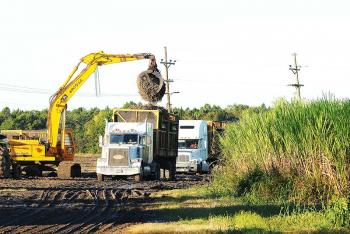
Farmers harvest St. Mary Parish sugar cane in this file photo. Farmers are among those who are expressing alarm about new Environmental Protection Agency rules they think could give the federal agency too much power to regulate even small water features, including ponds and ditches.
Boustany ‘deeply skeptical’ of rule
U.S. Rep. Charles Boustany, R-Lafayette, is concerned the U.S. Environmental Protection Agency’s final version of the “Waters of the U.S. Rule” issued Wednesday is merely attacking Louisiana agriculture by requiring the regulation of drainage ditches and farm ponds, he said in a news release.
“As we take time to review this final rule, I am deeply skeptical that this will amount to anything more than an attack on Louisiana agriculture,” Boustany said in the news release.
“Time and again the Administration has failed to take into account stakeholder concerns and real, on-the-ground impacts for farmers and small businesses. The House has taken action to defund the implementation of this rule and force the agency to rescind it — it’s time for the Senate to act. Louisiana’s farmers and small businesses are depending on it,” Boustany said.
On March 25, 2014, the Environmental Protection Agency issued the “Waters of the U.S. Rule” under the jurisdiction of the Clean Water Act granting the agency broad authority over all bodies of water, including drainage ditches and farm ponds, the Boustany news release stated.
Louisiana farmers worry this would give the EPA far too much authority over small, non-navigable bodies of water the original law had no intent of regulating, according to the release.
St. Mary Levee District Executive Director Tim Matte said levee district officials’ concern regarding the rule is that a “broadening of the definition of Waters of the U.S.” will require agencies, such as the U.S. Army Corps of Engineers, to be involved in more permitting procedures for flood protection projects.
Permitting is already a “laborious process” so adding more regulation of development, for areas that haven’t traditionally been regulated under Waters of the U.S., will only exacerbate delays in the permitting process, Matte said.
“It still continues to be a real big concern for us,” Matte said.
People are concerned that drainage canals and things on their private property that they “never thought about having to get a permit for,” could now require a permit, Matte said.
According to an EPA news release, the Clean Water rule finalized Wednesday is designed “to clearly protect from pollution and degradation the streams and wetlands that form the foundation of the nation’s water resources.”
It ensures that waters protected under the Clean Water Act are defined more precisely and predictably determined, decreasing permit costs, while making the permit process easier and faster for businesses and industry, the EPA release stated.
The rule does not create any new permitting requirements for agriculture and maintains all previous exemptions and exclusions, according to the EPA’s website.
The new rule “clearly defines and protects tributaries that impact the health of downstream waters,” according to the EPA. The Clean Water Act protects navigable waterways and their tributaries and the new rule states that a tributary must show physical features of flowing water, including a bed, bank and an ordinary high water mark, in order to warrant protection, EPA officials say.
According to the EPA, the rule does the following.
—Provides protection for headwaters that have these features and science shows can have a significant connection to downstream waters.
—Provides certainty in how far safeguards extend to nearby waters. The rule protects waters that are next to rivers and lakes and their tributaries because science shows that they impact downstream waters. The rule sets boundaries on covering nearby waters for the first time that are physical and measurable.
—Protects the nation’s regional water treasures. Science shows that specific water features can function like a system and impact the health of downstream waters.
—Focuses on streams, not ditches. The rule limits protection to ditches that are constructed out of streams or function like streams and can carry pollution downstream. So ditches that are not constructed in streams and that flow only when it rains are not covered.
—Maintains the status of waters within Municipal Separate Storm Sewer Systems. The rule does not change how those waters are treated and encourages the use of green infrastructure.
—Reduces the use of case-specific analysis of waters. Previously, almost any water could be put through a lengthy case-specific analysis, even if it would not be subject to the Clean Water Act. The rule significantly limits the use of case-specific analysis by creating clarity and certainty on protected waters and limiting the number of similarly situated water features, according to the EPA.
In January, Boustany cosponsored the Waters of the U.S. Regulatory Overreach Protection Act, introduced by U.S. Rep. Paul Gosar, R-Arizona. This bill requires the EPA and other federal agencies to scrap this rule, consult with state and local entities, and come up with a new proposal requiring congressional approval, according to the Boustany news release. Boustany is one of 114 original cosponsors of the bill.
In April, the House passed the Energy and Water Appropriations bill for the 2016 fiscal year, including legislative language barring funding from use to implement the EPA’s rule, the release stated.
On May 12, the House passed the Regulatory Integrity Protection Act, which requires the EPA to withdraw the Waters of the U.S. Rule within 30 days and mandates the agency work through local stakeholders in a transparent and accountable process if it wishes to revise the rule. The Senate has yet to act on either of these bills, Boustany said in the release.
- Log in to post comments
